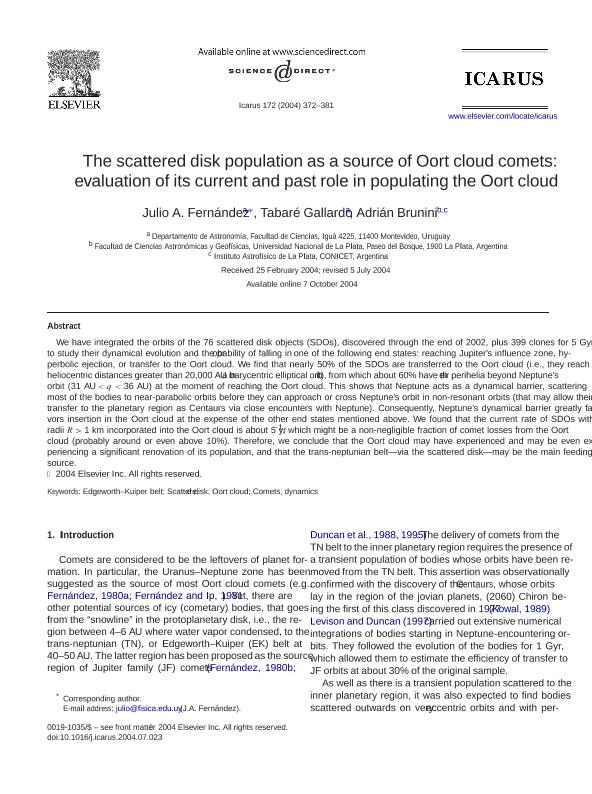Mostrar el registro sencillo del ítem
dc.contributor.author
Fernández, Julio A.

dc.contributor.author
Gallardo, Tabaré

dc.contributor.author
Brunini, Adrian

dc.date.available
2018-02-20T16:52:03Z
dc.date.issued
2004-12
dc.identifier.citation
Fernández, Julio A.; Gallardo, Tabaré; Brunini, Adrian; The scattered disk population as a source of Oort cloud comets: evaluation of its current and past role in populating the Oort cloud; Academic Press Inc Elsevier Science; Icarus; 172; 2; 12-2004; 372-381
dc.identifier.issn
0019-1035
dc.identifier.uri
http://hdl.handle.net/11336/36810
dc.description.abstract
We have integrated the orbits of the 76 scattered disk objects (SDOs), discovered through the end of 2002, plus 399 clones for 5 Gyr to study their dynamical evolution and the probability of falling in one of the following end states: reaching Jupiter's influence zone, hyperbolic ejection, or transfer to the Oort cloud. We find that nearly 50% of the SDOs are transferred to the Oort cloud (i.e., they reach heliocentric distances greater than 20,000 AU in a barycentric elliptical orbit), from which about 60% have their perihelia beyond Neptune's orbit (31 AU<q<36 AU) at the moment of reaching the Oort cloud. This shows that Neptune acts as a dynamical barrier, scattering most of the bodies to near-parabolic orbits before they can approach or cross Neptune's orbit in non-resonant orbits (that may allow their transfer to the planetary region as Centaurs via close encounters with Neptune). Consequently, Neptune's dynamical barrier greatly favors insertion in the Oort cloud at the expense of the other end states mentioned above. We found that the current rate of SDOs with radii R>1 km incorporated into the Oort cloud is about 5 yr−1, which might be a non-negligible fraction of comet losses from the Oort cloud (probably around or even above 10%). Therefore, we conclude that the Oort cloud may have experienced and may be even experiencing a significant renovation of its population, and that the trans-neptunian belt—via the scattered disk—may be the main feeding source.
dc.format
application/pdf
dc.language.iso
eng
dc.publisher
Academic Press Inc Elsevier Science

dc.rights
info:eu-repo/semantics/openAccess
dc.rights.uri
https://creativecommons.org/licenses/by-nc-sa/2.5/ar/
dc.subject
Edgeworth–Kuiper Belt
dc.subject
Scattered Disks
dc.subject
Oort Cloud
dc.subject
Comets
dc.subject
Dynamics
dc.subject.classification
Astronomía

dc.subject.classification
Ciencias Físicas

dc.subject.classification
CIENCIAS NATURALES Y EXACTAS

dc.title
The scattered disk population as a source of Oort cloud comets: evaluation of its current and past role in populating the Oort cloud
dc.type
info:eu-repo/semantics/article
dc.type
info:ar-repo/semantics/artículo
dc.type
info:eu-repo/semantics/publishedVersion
dc.date.updated
2018-02-19T16:54:22Z
dc.journal.volume
172
dc.journal.number
2
dc.journal.pagination
372-381
dc.journal.pais
Estados Unidos

dc.journal.ciudad
Washington
dc.description.fil
Fil: Fernández, Julio A.. Facultad de Ciencias; Uruguay
dc.description.fil
Fil: Gallardo, Tabaré. Facultad de Ciencias; Uruguay
dc.description.fil
Fil: Brunini, Adrian. Universidad Nacional de la Plata. Facultad de Ciencias Astronómicas y Geofísicas; Argentina. Consejo Nacional de Investigaciones Científicas y Técnicas. Centro Científico Tecnológico Conicet - La Plata. Instituto de Astrofísica La Plata. Universidad Nacional de La Plata. Facultad de Ciencias Astronómicas y Geofísicas. Instituto de Astrofísica la Plata; Argentina
dc.journal.title
Icarus

dc.relation.alternativeid
info:eu-repo/semantics/altIdentifier/doi/http://dx.doi.org/10.1016/j.icarus.2004.07.023
dc.relation.alternativeid
info:eu-repo/semantics/altIdentifier/url/https://www.sciencedirect.com/science/article/pii/S0019103504002210?via%3Dihub
Archivos asociados
